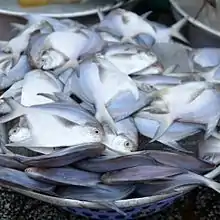Pampus argenteus
The silver pomfret or white pomfret (Pampus argenteus) is a species of butterfish that lives in coastal waters off the Middle East, South Asia, and Southeast Asia. The species now also occurs in the Mediterranean, having colonized it as part of Lessepsian migration through the Suez Canal.[1] Fish of this family are characterized by their flat bodies, forked tail fins, and long pectoral fins.[2]
| Silver pomfret | |
|---|---|
 | |
| Pampus argenteus | |
| Scientific classification | |
| Kingdom: | Animalia |
| Phylum: | Chordata |
| Class: | Actinopterygii |
| Order: | Scombriformes |
| Family: | Stromateidae |
| Genus: | Pampus |
| Species: | P. argenteus |
| Binomial name | |
| Pampus argenteus (Euphrasén, 1788) | |
| Synonyms | |
| |
Silver pomfrets are usually silver/white in color, with few small scales. They can grow up to a range of 4–6 kg (8–13 lb). However, due to overfishing, specimens weighing less than 1 kg (2 lb) are more commonly seen.
The silver pompano should not be mistaken for the Florida pompano (Trachinotus carolinus), which is a jackfish found off the coast of Florida in the Gulf of Mexico, and neither should be confused with true pomfrets, which are of the family Bramidae.
As food
This fish is prized in the Indo-Asia-Pacific region for its taste. Its flesh is soft and buttery when cooked. It is called pamplet or Maanji in Mumbai and vawall in parts of South India. It is called zubaidi in Arabic, which is derived from the word zubdah, which means butter, due to its tender flesh. In Malaysia it is known as bawal putih.
In Korea, the fish is known as byeongeo (병어) and is often grilled into gui and eaten as a banchan (side dish). It is also a popular dish in Chinese cuisine, often served steamed or braised.
 Byeongeo-gui (grilled pomfret)
Byeongeo-gui (grilled pomfret)
References
- Rodríguez, G.; Suárez, H. (2001). "Anthropogenic dispersal of decapod crustaceans in aquatic environments". Interciencia. 26 (7): 282–288.
- Froese, Rainer and Pauly, Daniel, eds. (2014). "Pampus argenteus" in FishBase. November 2014 version.